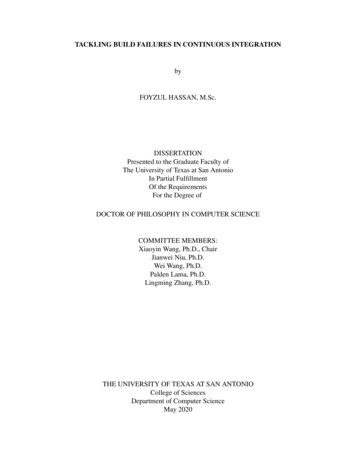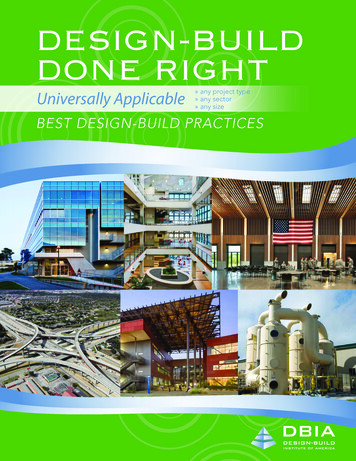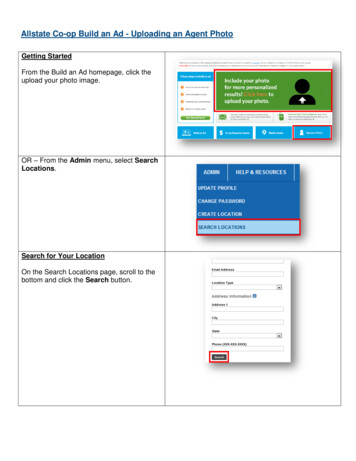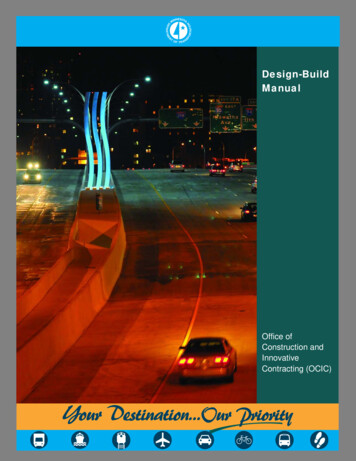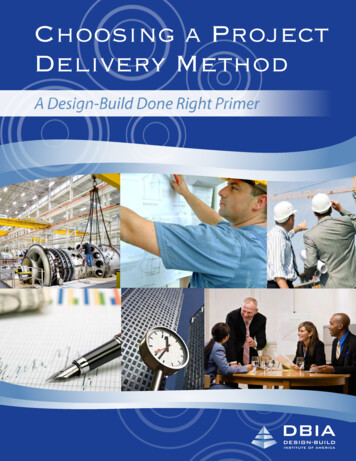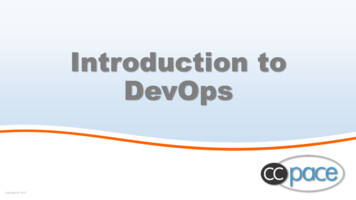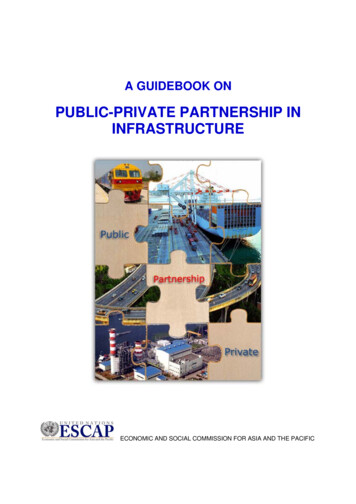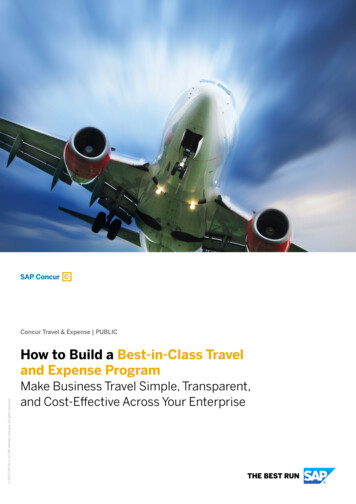
Transcription
Concur Travel & Expense PUBLIC 2021 SAP SE or an SAP affiliate company. All rights reserved.How to Build a Best-in-Class Traveland Expense ProgramMake Business Travel Simple, Transparent,and Cost-Effective Across Your Enterprise
Table of Contents4Challenges in Travel and Expense Management5Key Objectives of a Travel and Expense Program6Implementing Your Travel and Expense Programin Four Phases7PHASE ONE: Discover, Align, DeliverEvaluate Current Operations and Build aNew Framework9PHASE TWO: Standardize, Simplify, DigitalizeOptimize Processes Through Digital Enablement11PHASE THREE: Unify, Track, and TrimUnderstand Travel Spend, Trends, and Behavior13 PHASE FOUR: Engage, Save, and SatisfyKeep Your Travel Community Productive, Safe,and Happy15 Realize the Benefits of Operational Excellencein Travel and Expense2 / 15 2021 SAP SE or an SAP affiliate company. All rights reserved.
Travel is coming back – and businesses areonce again taking to the road, rails, and skies.But in our new, postpandemic world of work,adaptability is critical. Companies must balanceemployee safety and satisfaction with costcontrol and the visibility needed to stay flexiblein the face of change. This means making traveland expense (T&E) management faster, simpler,and more convenient while also ensuring travelbudgets are allocated and spent wisely.The answer is: an integrated T&E program.3 / 15 2021 SAP SE or an SAP affiliate company. All rights reserved.
Challenges in Travel and Expense ManagementFor many companies, T&E management canbe difficult and cumbersome for employees,managers, and auditors alike.Even when a T&E program exists, it is often notaligned – with fragmented processes and reporting that vary across multiple countries, states,or locations. Add outdated paper-, e-mail-, andspreadsheet-based expense management tothe mix, and lines of business lack the clear,actionable data and analytics they need togain full trans parency into T&E card programs.This lack of clarity creates extra work for T&Emanagers, keeping them from focusing on policycompliance, process efficiency, user satisfaction,supplier savings, and spend management. Italso makes it hard to identify program gaps andnoncompliant, excessive, and even fraudulentspend – especially in lodging, air travel, mileage,and entertainment reimbursement.The result can be a general lack of T&E oversight,expense reporting errors, and travelers bookingoutside your preferred channels. On top of this,limited T&E management services can make ithard for employees to get the help they needwhen they need it. Businesses may also sufferfrom a limited view of suppliers, putting themat a disadvantage when securing contractsand making it hard to maximize on discountsand promotions and realize economies of scale.Finally, all of these issues are often exacerbatedby the lack of a clear, up-to-date, and easilyaccessible T&E policy.Simply stated, a disjointed T&E program constrains successful management of travel spendand employee services. Luckily, most companieshave many opportunities for improvement.The purpose of this document is to show youhow to discover the gaps in your own T&Emanagement processes and policies, andthen gather the support and build the visionand operational framework for a truly unifiedT&E program.A well-organized T&E programprotects your company from thepitfalls of disjointed T&E processes,policies, and services while helpingease compliance, maximizebudgets, and ensure travelersatisfaction.4 / 15 2021 SAP SE or an SAP affiliate company. All rights reserved.
Key Objectives of a Traveland Expense ProgramAs you build or improve your T&E program, there arethree key goals to keep in mind: Accelerate the travel procure-to-pay cycle, reducecomplexity, and increase convenience for all involved Ensure compliance with internal spend policies andwith shifting tax liability and regulatory requirements Track all T&E spend to get the most out of your travelbudgetOverall, you need to consider the following actions: Unify T&E processes, policies, and practices across yourorganizations Simplify and streamline end-to-end travel booking andexpense reporting Optimize resources to provide a higher level of serviceand assistance to employees wherever they are inthe world Empower business travelers to make smarter decisionsand improve compliance by embedding policy rules intoevery transaction Give travel managers and finance a comprehensive viewof T&E data to track spend, identify trends, craft effectivetravel policies, and promote smart spend behavior Realize greater economies of scale to get better dealsfrom travel and related service providersThe more disconnected your T&E management, the moredaunting the task of building a single unified T&E programmay seem. But, with this guide and a phased approach,you should be able to do it in less than a year.Today’s business traveler expects speed,simplicity, and convenience. The goal ofyour T&E program should be to keeptravelers satisfied while also ensuringcompliance and tight spend control.5 / 15 2021 SAP SE or an SAP affiliate company. All rights reserved.
Implementing Your Travel and Expense Programin Four PhasesBuilding or improving your T&E program is amultistage process aimed at making travel assimple as possible while ensuring policy compliance and providing transparency into T&Etransactions and data. You need to align yourT&E and finance experts, executive leadership,and business users on program pain points, gaps,and requirements – then provide them with thetools and technology they need to realize thoserequirements. These tools should also be used tohelp managers, security teams, and risk assessment officers locate travelers to maintain safetyand quickly react in case of emergency. Evaluate your current processes and travelorganization, establish the framework for yourtravel program, align with management, andset up a service strategy to make it happen Optimize, standardize, and digitalize T&E management processes across your organization Centralize data and deploy advanced analyticsto track your program, identify trends, and takeaction to make travel more cost-effective andhelp ensure compliance Review new services to determine if you areproviding the most value in terms of cost andemployee productivity, satisfaction, and safetyTo do all this requires a four-phased approach(see Figure 1), during which you will:Typically, this process should take six to ninemonths to complete, but it is possible to runphases in parallel to accelerate rollout.Figure 1: Timeline for the Four Phases of Building a Travel and Expense ProgramPHASE ONEDiscover,align, deliverJANFEBMARPHASE TWOStandardize,simplify, digitalizeAPRMAYPHASE THREEUnify,track, trimJUNJULAUGPHASE FOUREngage,save, satisfySEPOCTNOVDEC6 / 15 2021 SAP SE or an SAP affiliate company. All rights reserved.
PHASE ONEDiscover,align, deliverJANFEBMARPHASE TWOStandardize,simplify, digitalizeAPRMAYPHASE THREEUnify,track, trimJUNJULAUGPHASE FOUREngage,save, satisfySEPOCTNOVDECPHASE ONE: DISCOVER, ALIGN, DELIVERAlignEVALUATE CURRENT OPERATIONS ANDWork with senior leadership across your company to formalize your vision for the type ofprogram, policies, services, suppliers, communications, and reporting you want to achieve. If youhave a travel operations team, optimizing eachmember role is an important step in strengthening your organization’s value to the company.Otherwise, relying on your travel suppliers canbe a viable alternative in supporting your travelprogram – but you need to be sure you’re aligning with them to take full advantage of theirheadcount and the services they offer.BUILD A NEW FRAMEWORKThe goal of the first phase in your T&E programjourney is to take a close look at your processesand operational structure as it is today. Then, youwill align with your key stakeholders on a vision ofwhat your program should look like for your company. Finally, you will reorganize and centralizeyour T&E management operations to deliver theconvenient, consumer-grade travel service experience today’s employees have come to expect.DiscoverTake a deep dive into existing travel operations todetermine what is working, what is not, and whatis still unknown. This requires you to: Evaluate each aspect of your current T&Eprogram or processes (if no formal programis in place) Obtain feedback from travelers and all company stakeholders about what is working andwhat could be improved Identify areas where there is a lack of processand policy alignment across business units orregions Identify areas where travelers are going outsideof the company travel policy and processes,and determine the causeTo do this, you need to: Restructure, if necessary, and define roles andresponsibilities in a way that creates a singlefocused organizational unit Separate travel and card procurement responsibilities from travel and card operations Establish team leads to oversee travel management companies, communications, policiesand compliance, reporting, and service administration – all within your existing headcount7 / 15 2021 SAP SE or an SAP affiliate company. All rights reserved.
DeliverBuild a T&E management organization focused on streamlining T&E card operations and offering outstandingemployee service experiences.To do this, you need to: Align regional and global policies and procedures asmuch as possible Allow global travel and card teams to focus on operational efficiencies, employee services and satisfaction,and actionable data and analytics Create a closed-loop travel source-to-settle system andservice offering Ensure every team member and other aligned organizations, such as expense operations, are familiar with yourprimary service partners and new processes Make sure that preferred travel management companiesand other preferred service providers are on board andworking within your established processes Focus on creating a positive travel experience while alsoensuring employee accountability and complianceEvery traveler’s needs are unique. YourT&E management teams must be focusedon meeting and exceeding employeeexpectations while keeping a close eyeon spend.8 / 15 2021 SAP SE or an SAP affiliate company. All rights reserved.
PHASE ONEDiscover,align, deliverJANFEBMARPHASE TWOStandardize,simplify, digitalizeAPRMAYPHASE THREEUnify,track, trimJUNJULAUGPHASE FOUREngage,save, satisfySEPOCTNOVDECPHASE TWO: STANDARDIZE,SimplifySIMPLIFY, DIGITALIZENow that all your regional T&E processes havebeen documented, mapped against each other,and synchronized, it’s time to review and layerthe various workflows to identify redundanciesand help eliminate unnecessary steps. To do this,you need to: Evaluate each process step and ask your ITteam if there is a simpler, more-efficient digitalsolution Create a unified T&E policy that can be appliedacross regional and global operations Consolidate your list of preferred T&E serviceproviders so you can offer employees standardservices and consistent, cost-effective pricing Align and integrate your corporate card programacross the enterprise to include meetings andevents, which tend to be handled separatelyOPTIMIZE PROCESSES THROUGHDIGITAL ENABLEMENTYou now have a unified vision for your T&E program and have established the roles, responsibilities, and services of your T&E management team.The next phase in making this program a reality isoptimizing your processes through standardi zation, simplification, and digital enablement.Not only will this make work easier for travelers,managers, and auditors, but it will also give you aflexible IT framework that can be quickly adjustedand scaled to meet changing business needs.StandardizeNow that you have identified your T&E processbest practices, problem areas, and gaps, it is timeto standardize those processes across businessunits and regional areas. Focus on travel, card,and expense processes across operations so youcan document and layer current processes ontop of one another – then decide how best tosynchronize. To do this, you need to: Map your process flows from end to endso you can visualize each step Create standard T&E management processesfrom source to settle that can be implementedacross your operationsLogging expenses, submittingreports, and following up onworkflows should be simple. Notonly does it make your T&E dataeasier to track, but it also frees uptime for finance teams and travelersto focus on value-adding tasks.9 / 15 2021 SAP SE or an SAP affiliate company. All rights reserved.
Digitalize Automate manual T&E data capture, reporting,We’ve seen that a core component of simplificaand approval processestion is digitalization. And when it comes to digital Enable mobile, self-service access to data andaccess, employee expectations are changing.workflows from any devicePeople want the same level of convenience at work Provide greater transparency to travelers aboutthat they have in their personal lives. With the rightexpense report status and reimbursementtools and technology, you can automate timetimesconsuming and error-prone tasks – improving Configure compliance rules and alerts intoaccuracy and centralizing data. Digitalization canevery transactionalso mean giving your employees tools that allow Leverage partner reimbursement technologiesthem to stay productive on the road while saving Capture the data you need to help ensure fulltime for managers, auditors, and service teams.transparency and oversight of travel spend andWith the right T&E management technology,enable comprehensive analytics for your T&Eyou can:program10 / 15 2021 SAP SE or an SAP affiliate company. All rights reserved.
PHASE ONEDiscover,align, deliverJANFEBMARPHASE TWOStandardize,simplify, digitalizeAPRMAYPHASE THREEUnify,track, trimJUNJULAUGPHASE FOUREngage,save, satisfySEPOCTNOVDECPHASE THREE: UNIFY, TRACK, TRIMUNDERSTAND TRAVEL SPEND, TRENDS, AND BEHAVIORT&E data is one of your most valuable assets. But if your travel managers and finance teams can’teasily access and analyze it, that value is lost. You’ve already begun the critical move toward digitallytransforming your T&E program. Now, you need to be sure you can track trends in travel costs andbehavior, then trim your travel spending in a way that makes sense for travelers and for your company.UnifyThe first step in understanding travel trends and behavior at your company is unifying your data toprovide travel managers and finance teams with a single source of truth. To do this, you need to: Deploy a single, integrated T&E management solution across your company to align disparateinternal and external sources for T&E data– Even if you don’t have an integrated solution yet, integrate whatever T&E management applications you do have with back-end finance and accounting systems so that T&E spend can beviewed in the context of overall company spend and budgets. Connect direct supplier bookings to T&E systems to gain visibility regardless of where bookingstake place Provide clear, user-friendly T&E reporting and analytics that allow management access to actionable insights11 / 15 2021 SAP SE or an SAP affiliate company. All rights reserved.
TrackTrimOnce you have a single source of T&E data, thenext step is to determine the things you shouldbe tracking and make those reports and analyticsas simple and intuitive as possible. To do this,you need to: Implement a single, user-friendly tool for T&Edashboard reporting Establish key performance indicators (KPIs)and create actionable data sets for all enterprise business roles that need T&E analytics Take advantage of machine learning andadvanced analytics to help expense auditorsmonitor and identify spending trends by business unit, region, individual, time period, andmoreNow that you have determined and can track theKPIs for your T&E program, it’s time to turn thatinsight into action. Use reports to increase awareness among management and travelers andeducate them on how to modify behaviors in away that increases efficiency and productivitywhile also reducing costs. To do this, you need to: Increase the focus on high-dollar, questionable,and fraudulent spending Identify trends in corporate card spendby monitoring the level of spend acrossall regions Identify high-frequency suppliers to win moreadvantageous contracts Ensure suppliers offer total revenuetransparency Promote smart spending behaviors that keepemployees productive on the roadwhile also protecting your bottom lineYour ability to make smart businessdecisions is only as good as theinformation you have. In a worldwhere change is the only constant,staying ahead of T&E trends cangive your program the insightand agility to succeed.Waste and noncompliance oftenbuild up over time. But with theright data at your fingertips, you canquickly find it, fix it, and help yourtravel community make the bestspending choices moving forward.12 / 15 2021 SAP SE or an SAP affiliate company. All rights reserved.
PHASE ONEDiscover,align, deliverJANFEBMARPHASE TWOStandardize,simplify, digitalizeAPRMAYPHASE THREEUnify,track, trimJUNJULAUGPHASE FOUREngage,save, satisfySEPOCTNOVDECPHASE FOUR: ENGAGE, SAVE, SATISFYSaveKEEP YOUR TRAVEL COMMUNITYWhen determining new cost-saving measures, it’simportant to keep overall value in mind. Whetherthat means maximizing employee productivity,making the most of discounts, or avoiding up-frontcosts and fees, there is more to saving money thanmeets the eye. To help ensure you’re getting themost from your T&E program budget, you should: Accelerate expense report submission, processing, and reimbursement cycles to lower costs Roll out tools and processes that save time foremployees, managers, and auditors – increasingoverall workforce productivity Increase compliance with T&E policies toreduce excessive or fraudulent spend Continually update your list of preferred hospitality providers to help ensure your people are getting the best rates as well as VIP guest servicesPRODUCTIVE, SAFE, AND HAPPYNow that your T&E program is in place, the lastphase is to find out how well it’s working and makea plan for continued improvement. You need toengage with your business travel community aswell as finance and IT teams to establish lines ofcommunication and periodic check-ins aroundservice levels, technology, cost savings, programvalue, and overall satisfaction.EngageTo help ensure you deliver on service commitments to travelers and other expense submitters,you need to engage with the people you are serving. To better connect about new processes andpolicies and evaluate how well you are doing,you need to: Train business units and employees on T&Eprocesses and best practices using concise,engaging communications and easily consumable content channels, such as social mediaand video Gather and take action on employee feedbackthrough voice-of-the-customer engagements Track and publicize service improvementsthrough KPIs, such as a reduction in supporttickets, faster response times, and so onA well-run T&E program can leadto significant savings in time,money, and effort. But the cheapestoption is not always the mostcost-effective. Find the option thatacknowledges happy, productiveemployees as one of your mostvaluable assets.13 / 15 2021 SAP SE or an SAP affiliate company. All rights reserved.
SatisfyWhen measuring the success of your T&E program, employee satisfaction is a critical indicator.Meeting the needs of all types of employees –including longtime team members and new hires– helps get people on board to support yourtravel program and keeps them engaged. If thepandemic taught us anything, it is that, in additionto comfort and convenience, employee safetyshould always be top of mind. When it comes torisk mitigation, the question is not if but when,where, and to what magnitude. To help alleviatefriction, enhance safety, and drive continuousadoption of your T&E processes and policies,you need to: Consider the unique needs of employeesacross all demographics as you evolve yourT&E management strategy Work with employees, security, and HR toaddress duty-of-care concerns and streamlineonboarding for new hires by setting travelexpectations and requirements Work with suppliers to develop unique servicesthat can enhance your employee travelexperience Connect with travelers through targeted communications that can ease and improve theirtravel experience and help keep them safe inthe event of an emergencyBusiness travel can be stressful.A travel manager’s role is not topolice but to advise. The goal shouldbe to serve as a trusted businessadviser and partner that helpssupport employee and companysuccess on every business trip.14 / 15 2021 SAP SE or an SAP affiliate company. All rights reserved.
Realize the Benefits ofOperational Excellencein Travel and ExpenseCreating a new or improved T&E management programprovides clear benefits for your company and youremployees – especially now that flexibility, safety,and convenience are staples of our new world of work.When you unify T&E processes, policies, practices, anddata across your enterprise, you provide greater clarityand consistency for travelers and travel managers alike.Not only does this make everyone more efficient, butit also helps ensure compliance with T&E policy andstrengthens supplier partnerships so you can enhanceservices and better leverage economies of scale.When you unifyT&E processes,policies, practices,and data across yourenterprise, you providegreater clarity andconsistency fortravelers and travelmanagers alike.By providing convenient, user-friendly services and toolsto improve the travel experience, streamline end-to-endbooking, and simplify the expense-to-reimbursementprocess, you help employees stay focused on the purposeof the trip – supporting their success and boosting theiroverall job satisfaction. Plus, you gain the centralized datayou need to give finance the visibility it needs to identifytrends, flag issues, and determine the most valuable andcost-effective T&E strategy for your company.Finally, with a unified T&E team and processes in place,you can quickly scale your program to accommodategrowth and evolving business needs.When you’re ready to explore building or enhancing yourown travel program, contact your SAP Concur solutionsaccount manager. Our team is here to help ensure yourpolicy and program fit your needs and to help you makethe most of your T&E solution investment.15 / 15 2021 SAP SE or an SAP affiliate company. All rights reserved.
Follow SAP ConcurLearn more at concur.comStudio SAP 76293enUS (21/09) 2021 SAP SE or an SAP affiliate company. All rights reserved.No part of this publication may be reproduced or transmitted in any formor for any purpose without the express permission of SAP SE or an SAPaffiliate company.The information contained herein may be changed without prior notice.Some software products marketed by SAP SE and its distributors containproprietary software components of other software vendors. Nationalproduct specifications may vary.These materials are provided by SAP SE or an SAP affiliate company forinformational purposes only, without representation or warranty of anykind, and SAP or its affiliated companies shall not be liable for errors oromissions with respect to the materials. The only warranties for SAP orSAP affiliate company products and services are those that are set forthin the express warranty statements accompanying such products andservices, if any. Nothing herein should be construed as constituting anadditional warranty.In particular, SAP SE or its affiliated companies have no obligation topursue any course of business outlined in this document or any relatedpresentation, or to develop or release any functionality mentioned therein.This document, or any related presentation, and SAP SE’s or its affiliatedcompanies’ strategy and possible future developments, products, and/orplatforms, directions, and functionality are all subject to change andmay be changed by SAP SE or its affiliated companies at any time forany reason without notice. The information in this document is not acommitment, promise, or legal obligation to deliver any material, code, orfunctionality. All forward-looking statements are subject to various risksand uncertainties that could cause actual results to differ materially fromexpectations. Readers are cautioned not to place undue reliance on theseforward-looking statements, and they should not be relied upon in makingpurchasing decisions.SAP and other SAP products and services mentioned herein as well astheir respective logos are trademarks or registered trademarks ofSAP SE (or an SAP affiliate company) in Germany and other countries.All other product and service names mentioned are the trademarks oftheir respective companies.See www.sap.com/trademark for additional trademark informationand notices.
4 Challenges in Travel and Expense Management 5 Key Objectives of a Travel and Expense Program 6 Implementing Your Travel and Expense Program in Four Phases 7 PHASE ONE: Discover, Align, Deliver Evaluate Current Operations and Build a New Framework 9 PHASE TWO: Standardize, Simplify, Digitalize Optimize Processes Through Digital Enablement 11 PHASE THREE: Unify, Track, and Trim


